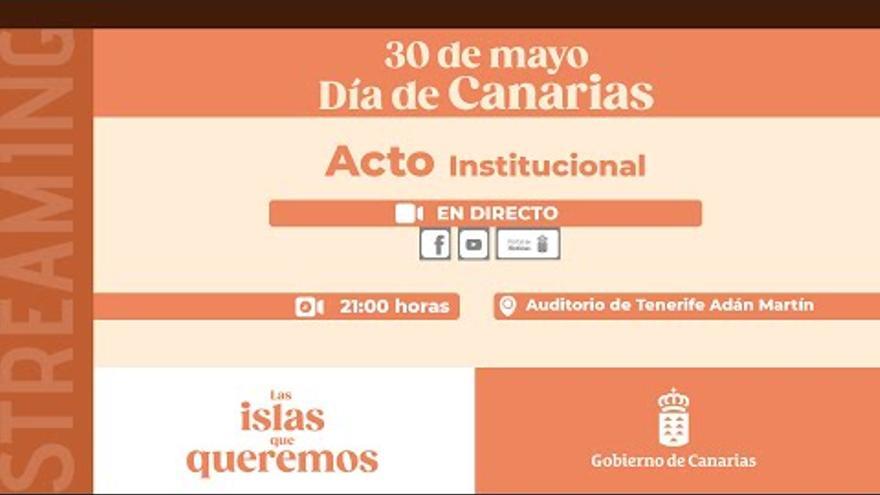
The Auditorio de Tenerife hosts the institutional celebration of the Day of the Canary Islands, in which the regional government will deliver the Canary Islands Awards and the Gold Medals of this year.
Canary Islands Awards
Spanish Association against Cancer in the Canary Islands
The Spanish Association Against Cancer (AECC) in the Canary Islands celebrates 30 years of helping and supporting cancer patients and their families in the Archipelago. The activity of the AECC began in Madrid now 69 years ago. As of today, the AECC has 40 apartments and residences throughout Spain, five of them in the Canary Islands.
German Pepe
José A. Alemán is one of the most prestigious figures in Canarian journalism. Since the end of the sixties of the last century, she has participated in publications and various media, focusing above all on the political, economic and cultural information, without ever hiding his defense of democracy and freedoms in the dictatorship stage.
NGO Coordinator for the Development of the Canary Islands
The Coordinator of NGOs for the Development of the Canary Islands integrates 31 entities of the islands, it is the only organization that represents this area in the archipelago and belongs to the State Coordinator of NGDOs and the Network of Autonomous Coordinators. It arises in 1995 in Tenerife. In 1998 it was also created in Gran Canaria and, in 2005, they merged and the Coordinadora de ONGD de Canarias was born.
Gold medals
Alexis Ravelo
Recently deceased, Alexis Ravelo receives the Gold Medal of the Canary Islands posthumously. The prolific writer is the author of more than fifteen novels, and was awarded the Café Gijón Award and the Hammett Award.
Maria Theresa Cotonat
María Teresa Cotonat has been providing her services as a pediatrician in El Hierro since the year 2000. Known as the pediatrician of El Hierro, she was recently granted the Civil Health Order.
rebecca rodriguez
Patron of the Salvamar Tenerife, one of the three rapid intervention vessels that Salvamento Marítimo has in Fuerteventura. She has participated in the rescue of migrants.
Ana Bautista Reyes
Ana Bautista has a sports hall with her name in Santa Cruz de Tenerife. The rhythmic gymnast achieved Spain’s first official gold medal in this discipline.
Luis Herrera Mesa
Luis Herrera Mesa was born in La Gomera and is Professor of Biology and Professor of Zoology. Researcher on climate change and biodiversity, he is the Humboldt Prize and Favorite Son of La Gomera.
San Roque Hospitals
San Roque University Hospitals celebrated its centenary in 2020. It has been a hundred years as a benchmark for innovation in healthcare in Gran Canaria. Today it has seven centers.
Chicha Arozarena
María Luisa (Chicha) Arozarena is a benchmark in journalism in the Canary Islands. She worked for 24 years at RNE in the Canary Islands, as well as at the newspaper El Día or the Europa Press Agency.
Canarian Foundation Dr. Manuel Morales
This foundation created by the action of the doctor Manuel Morales Pérez (Mazo, 1902) receives the award for his philanthropic work in favor of the medical training of numerous young Canarians.
IES Felo Monzon
In 1973, the Labor University of Las Palmas was inaugurated in Tafira Baja, the seed of the IES Felo Monzón. These entities began in the fifties as spaces for academic and labor training.
Neither Fú-Ni Fá
The Ni Fú-Ni Fá Afilarmónica, the oldest murga of the Tenerife Carnival, was founded in the 1950s, although it was not until 1961 when it adopted its current name.
Kika’s Grandchildren
One of the pioneer groups of the carnival, the afilarmónica was founded in 1976. It won the I Prize for Interpretation of the contest that same year, in 1980 and 1982.
the rebellious
The Lanzarote murga, formed at the beginning of the eighties, was distinguished as the first female afilarmónica of the Canary Islands in 1997.
Parranda Los Buches
This formation is a tradition of being and feeling of the fishing village of Lanzarote. It is considered the maximum expression of the popular carnival of the Archipelago.
Canaries7
The header was born on October 2, 1982 at the price of 35 pesetas. In November 1995 its digital version appeared. In April 2005 it was published entirely in color.















